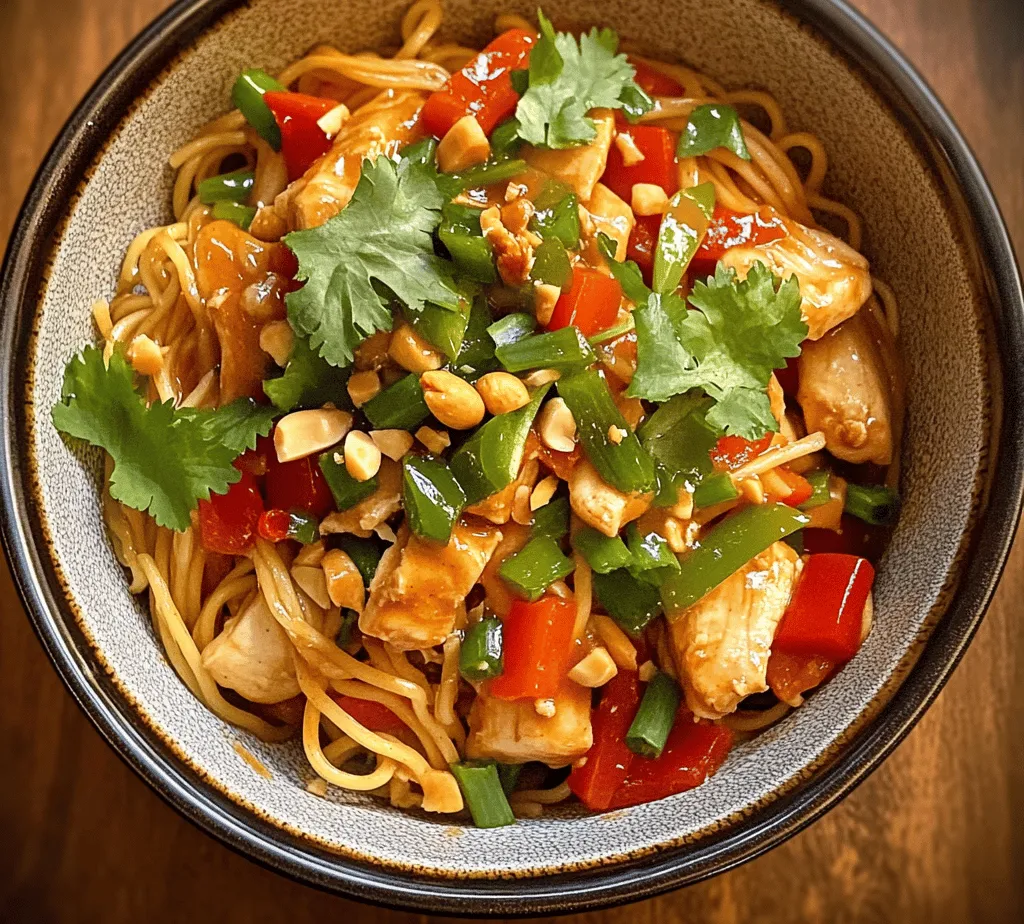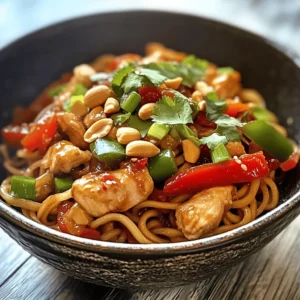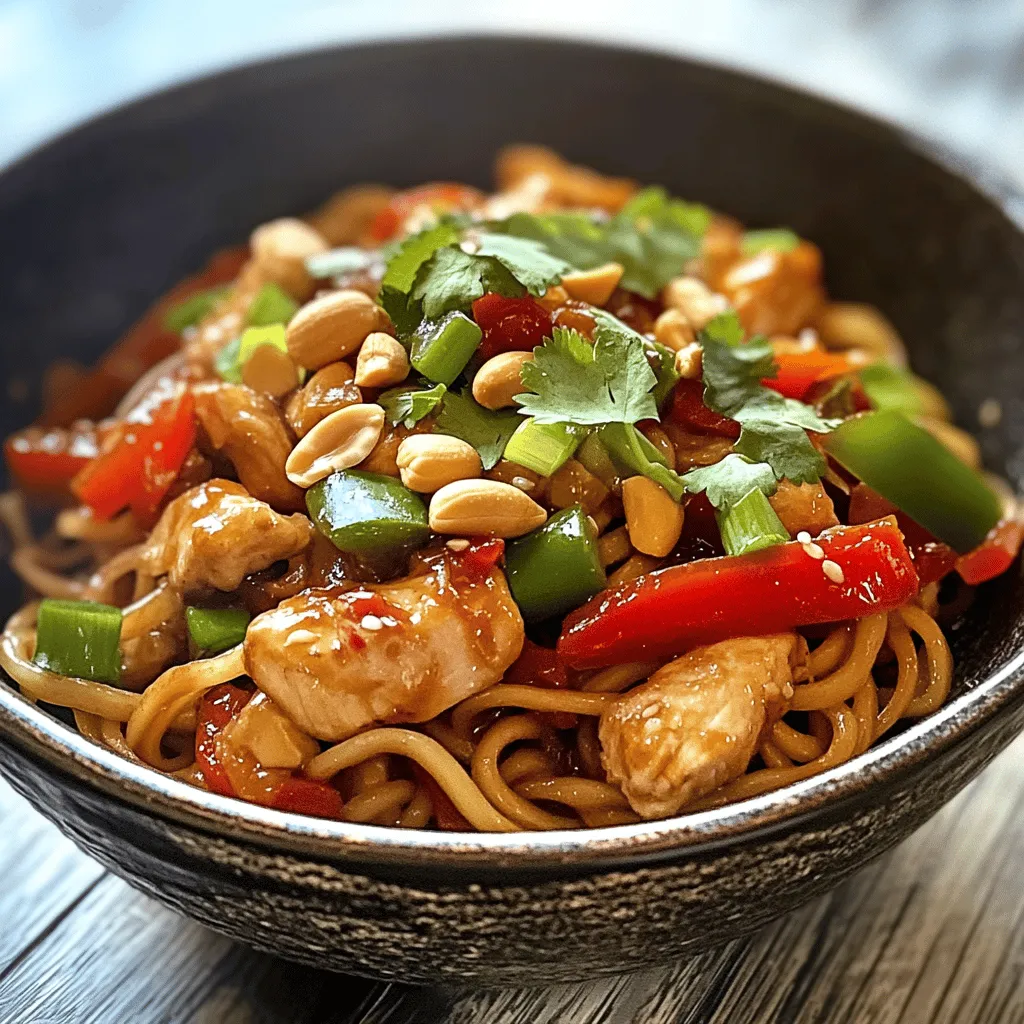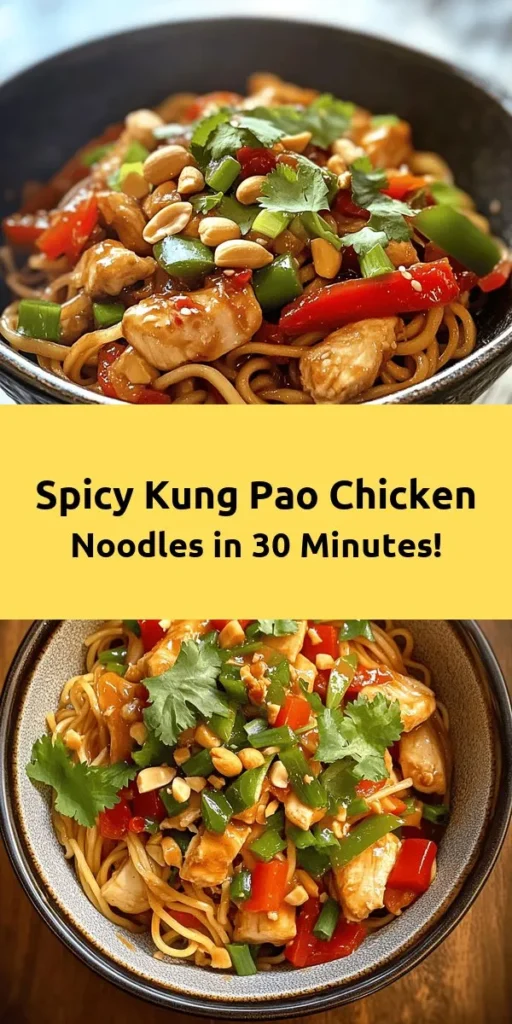Introduction
Kung Pao Chicken Noodles is a delightful dish that marries the bold flavors of traditional Chinese Kung Pao chicken with the comforting embrace of noodles. This fusion creates a culinary experience that’s both familiar and exciting, perfect for those seeking a quick weeknight meal or an impressive dish for entertaining guests. The vibrant mix of spices, textures, and colors not only makes for an appealing plate but also offers a delicious balance that pleases the palate.
In this recipe, you’ll discover how to create a robust sauce that combines the heat of chili paste, the umami of soy sauce, and the sweetness of hoisin, all enveloping tender chicken and fresh vegetables. The addition of roasted peanuts brings a satisfying crunch, making every bite a delightful experience. As we take a closer look at the ingredients and preparation methods involved, you’ll be ready to whip up this flavorful dish in no time.
Understanding Kung Pao Chicken
Kung Pao chicken has deep roots in Chinese cuisine, tracing its origins back to the Sichuan province. Traditionally known as “Gong Bao Ji Ding,” the dish was named after a Qing Dynasty governor, Ding Baozhen, who was fond of the meal. The original recipe consisted of diced chicken, peanuts, and vegetables stir-fried in a spicy sauce, showcasing the bold flavors characteristic of Sichuan cooking, particularly the use of Sichuan peppercorns that impart a unique numbing heat.
Over the years, as the dish traveled and adapted to different cultures, it has undergone various transformations. In the United States, for instance, the dish often features a sweeter sauce and is less spicy than its authentic counterpart. Today, Kung Pao chicken is beloved worldwide and is frequently adapted to include different proteins or noodles, resulting in the delicious variation of Kung Pao Chicken Noodles that we are preparing. This adaptation not only highlights the versatility of the dish but also showcases how traditional recipes can evolve while maintaining their essence.
Ingredients Breakdown
To create your own batch of Kung Pao Chicken Noodles, you’ll need the following ingredients, each playing a vital role in the dish’s flavor profile and texture:
Chicken Breast
The choice of chicken breast is ideal for this recipe due to its lean protein content and quick cooking time. It absorbs flavors well, retaining moisture while delivering a satisfying bite. Nutritionally, chicken breast is a great source of protein, low in fat, and packed with essential vitamins and minerals, making it a healthy option for any meal.
Egg Noodles
Egg noodles are a staple in many Asian dishes, providing a hearty base that complements the robust flavors of Kung Pao chicken. Their slightly chewy texture holds the sauce beautifully, ensuring that each bite is filled with flavor. For those with dietary restrictions, alternatives like rice noodles, zucchini noodles, or whole wheat noodles can be used without sacrificing the dish’s overall appeal.
Bell Peppers
In this recipe, both red and green bell peppers are utilized. The sweetness of red peppers contrasts beautifully with the slightly bitter taste of green peppers, creating a harmonious balance. Nutritionally, bell peppers are rich in vitamins A and C, as well as antioxidants, making them a healthy addition. Their vibrant colors also enhance the visual appeal of the dish, making it more enticing.
Aromatics
Garlic and ginger are essential aromatics in this recipe, as they form the foundation of the dish’s flavor. Garlic adds a savory depth, while ginger provides a fresh, zesty note that brightens the overall profile. Both ingredients are known for their health benefits, including anti-inflammatory properties and digestive support.
Sauces and Seasonings
The heart of Kung Pao Chicken Noodles lies in its sauce, which is a blend of several key ingredients:
– Soy Sauce: This staple provides a salty, umami flavor that enhances the dish’s overall profile.
– Hoisin Sauce: Known for its sweet and tangy taste, hoisin sauce adds complexity and richness to the dish.
– Rice Vinegar: A splash of rice vinegar offers a bright acidity that balances the flavors and cuts through the richness of the sauce.
– Chili Paste: For those who enjoy a kick, chili paste adds heat and depth, making it a crucial component for achieving that signature Kung Pao flavor.
Roasted Peanuts
These nuts are more than just a crunchy topping; they are a source of protein and healthy fats. Their rich, nutty flavor complements the spices in the dish and adds a satisfying crunch that contrasts beautifully with the tender chicken and vegetables.
Vegetable Oil and Sesame Oil
For cooking, a combination of vegetable oil and sesame oil is recommended. Vegetable oil has a high smoke point, making it suitable for stir-frying, while sesame oil adds a distinct flavor that enhances the dish’s authenticity. Using both oils allows for high-heat cooking without compromising on taste.
Fresh Garnishes
Finally, fresh garnishes such as sliced green onions and cilantro elevate the dish visually and flavor-wise. Green onions provide a mild onion flavor, while cilantro adds a fresh, herbal note that rounds out the dish beautifully.
Preparation Steps
Now that we have all the ingredients laid out, let’s walk through the preparation steps for creating your Kung Pao Chicken Noodles.
Step 1: Prepare the Ingredients
Begin by gathering all your ingredients and chopping them accordingly. Dice the chicken breast into bite-sized pieces, ensuring they are uniform for even cooking. Slice the bell peppers into strips or chunks based on your preference. Mince the garlic and ginger and set them aside.
Step 2: Marinate the Chicken
To enhance the chicken’s flavor, marinate it with a tablespoon of soy sauce and a dash of sesame oil. Allow it to rest for about 15-20 minutes, which will help infuse the flavors and tenderize the meat.
Step 3: Cook the Noodles
While the chicken is marinating, cook the egg noodles according to the package instructions. Drain and rinse them under cold water to stop the cooking process and prevent sticking. Set the noodles aside.
Step 4: Stir-Fry the Chicken
In a large wok or frying pan, heat a tablespoon of vegetable oil over medium-high heat. Once hot, add the marinated chicken in a single layer, allowing it to sear and brown on one side before stirring. Cook until the chicken is fully cooked through, about 5-7 minutes. Remove the chicken from the pan and set aside.
Step 5: Sauté the Vegetables
In the same pan, add another tablespoon of vegetable oil if needed. Toss in the minced garlic and ginger, stirring quickly to avoid burning. After about 30 seconds, add the sliced bell peppers and cook for 3-4 minutes until they are tender yet still crisp.
Step 6: Combine Ingredients
Return the cooked chicken to the pan with the vegetables and add the cooked noodles. Pour in the sauce mixture, which you can prepare by combining soy sauce, hoisin sauce, rice vinegar, and chili paste in a bowl before adding. Toss everything together, ensuring the noodles and chicken are evenly coated with the sauce.
Step 7: Add Peanuts and Garnish
Finally, stir in the roasted peanuts, mixing them well into the dish. Remove from heat and garnish with sliced green onions and cilantro for an added touch of freshness.
As you can see, preparing Kung Pao Chicken Noodles is a straightforward process that results in a dish bursting with flavor and texture. The combination of tender chicken, vibrant vegetables, and a rich sauce creates a satisfying meal that everyone will enjoy. As you follow these steps, you’ll be well on your way to impressing your family or guests with this culinary delight.

Cooking the Noodles
To create the perfect Kung Pao Chicken Noodles, the first step is to cook the noodles to ideal texture and consistency. Start by bringing a large pot of salted water to a rolling boil. Choose noodles that complement the dish well—egg noodles or rice noodles are excellent options for their ability to absorb flavors.
Once the water is boiling, add the noodles and cook them according to the package instructions, usually around 4 to 7 minutes. It’s crucial to check for doneness a minute or two before the suggested cooking time, as you want them to be just al dente. This means they should be firm to the bite but not overly soft, as they will continue to cook when combined with the other ingredients later.
Once cooked, drain the noodles in a colander, and rinse them under cold water to stop the cooking process. This also helps to remove excess starch, which can make the noodles gummy. For a slight flavor boost, consider tossing the drained noodles with a teaspoon of sesame oil or a drizzle of vegetable oil to prevent sticking and enhance their taste.
Making the Sauce
The sauce is the heart of Kung Pao Chicken Noodles, delivering the essential flavor profile that makes this dish so beloved. Begin by mixing together soy sauce, rice vinegar, hoisin sauce, and a touch of sugar in a bowl. The soy sauce provides umami and saltiness, while the rice vinegar adds tang, the hoisin lends sweetness and depth, and the sugar balances the flavors.
For those who enjoy a bit of heat, incorporate some chili paste or crushed red pepper flakes into the mixture. Adjust the level of spiciness based on personal preference, or offer it on the side for guests to add as they like.
To personalize the sauce further, consider adding a dash of sesame oil or a sprinkle of ground ginger for extra flavor complexity. Remember to taste and adjust the ingredients as needed to achieve that perfect balance of sweet, savory, and spicy that Kung Pao is known for.
Cooking the Chicken
Stir-frying the chicken is crucial to achieving that authentic taste and texture found in traditional Kung Pao chicken. Cut your chicken breast into bite-sized pieces, ensuring they are uniform to promote even cooking. Marinating the chicken in a mix of soy sauce, cornstarch, and a little water for about 15 minutes can enhance tenderness and help the chicken achieve a nice sear.
Heat a large wok or non-stick skillet over high heat and add a tablespoon of vegetable oil. Once the oil is shimmering, add the marinated chicken in a single layer, ensuring not to overcrowd the pan. This allows the chicken to sear instead of steam. Cook the chicken undisturbed for about 2-3 minutes or until it develops a golden-brown crust, then stir-fry until fully cooked, approximately another 2-3 minutes. This technique locks in moisture and flavor, resulting in succulent chicken pieces.
Stir-frying the Vegetables
To maintain the vibrant colors and crisp textures of the vegetables, stir-frying should be done quickly over high heat. After removing the chicken from the pan, add a bit more oil if necessary and toss in your prepped vegetables—bell peppers, zucchini, and snap peas are great choices.
Stir-fry the vegetables for about 2-3 minutes, just until they start to soften but still retain their crunch. This method not only keeps the vegetables colorful but also maximizes their nutritional benefits by minimally cooking them.
Remember to season the vegetables with a pinch of salt and pepper to enhance their natural flavors. Once they are just tender yet still vibrant, return the chicken to the pan.
Combining Ingredients
With all components cooked, it’s time to bring everything together. Pour the prepared sauce over the chicken and vegetable mixture, stirring well to ensure that every piece is coated in the flavorful sauce. Add the cooked noodles to the wok, tossing everything together gently but thoroughly. The goal is to achieve even flavor distribution without breaking the noodles.
Allow the dish to cook for an additional minute or two, just until everything is heated through and the sauce has thickened slightly. This final step allows the noodles to soak up some of the savory sauce, enhancing their flavor.
Finishing Touches
The last step in creating your Kung Pao Chicken Noodles is to add the finishing touches. Toss in some roasted peanuts for a delightful crunch and nutty flavor. Peanuts are a traditional ingredient in Kung Pao dishes, and they add both texture and a touch of richness.
For presentation, consider garnishing the dish with chopped green onions and a sprinkle of sesame seeds. These additions not only enhance the dish visually but also add layers of flavor and crunch.
Nutritional Information
Kung Pao Chicken Noodles provide a balanced meal with a variety of nutrients. A typical serving (approximately 1 cup) contains around 400-500 calories, depending on the specific ingredients used.
– Protein: Approximately 25-30 grams, thanks to the chicken, making it a good source of lean protein.
– Fat: Ranges from 15-20 grams, primarily from the oil and peanuts, contributing healthy fats.
– Carbohydrates: Roughly 50-60 grams, mostly from the noodles and vegetables, providing essential energy.
The ingredients in this dish also offer health benefits. Chicken is a great source of lean protein, while a variety of vegetables contributes vitamins, minerals, and antioxidants. Peanuts provide healthy fats and protein, making this dish not only delicious but also nutritious.
Variations and Substitutions
Kung Pao Chicken Noodles is highly versatile, allowing for numerous variations based on dietary preferences or ingredient availability:
– Protein Alternatives: For a vegetarian option, consider substituting the chicken with firm tofu, which can be marinated and stir-fried just like chicken. Shrimp also works beautifully, cooking quickly and adding a different flavor profile. For a heartier dish, you can use beef strips, adjusting the cooking time accordingly.
– Vegetable Variations: Feel free to incorporate other colorful vegetables based on your preference or what you have on hand. Broccoli, carrots, baby corn, or mushrooms can add both flavor and nutrition to your dish.
– Spice Level Adjustments: If you prefer a milder dish, reduce the amount of chili paste or omit it entirely. Alternatively, for those who enjoy spiciness, consider using fresh sliced chilies or a spicier chili oil for an extra kick.
– Gluten-Free Options: To make this dish gluten-free, swap out the soy sauce for tamari, which is gluten-free. Ensure that all other sauces and ingredients are gluten-free as well.
Serving Suggestions
Kung Pao Chicken Noodles can be served on its own, but it pairs wonderfully with various sides and beverages. Complement the dish with a light cucumber salad or steamed broccoli for additional greens.
For a more complete meal, consider serving it alongside a bowl of hot and sour soup or egg drop soup. When it comes to beverages, a crisp white wine or iced green tea can enhance the dining experience, balancing the flavors of the dish.
This recipe is perfect for casual weeknight dinners, but it can also elevate a more formal gathering. Its vibrant colors and bold flavors make it an excellent choice for impressing guests at a dinner party or a festive occasion.
Conclusion
Kung Pao Chicken Noodles is a delightful dish that brings the rich flavors of Chinese cuisine into your kitchen. With its easy preparation and wide-ranging adaptability, this recipe is not just delicious but also versatile enough to suit different dietary needs and preferences.
Whether you are cooking for family, entertaining guests, or just treating yourself to a satisfying meal, this dish promises to deliver on flavor and presentation. Embrace the vibrant mix of textures and tastes, and enjoy the process of creating this culinary masterpiece. With every bite, you will appreciate the balance of savory, sweet, and spicy that defines Kung Pao Chicken Noodles, making it a staple in your recipe repertoire.



